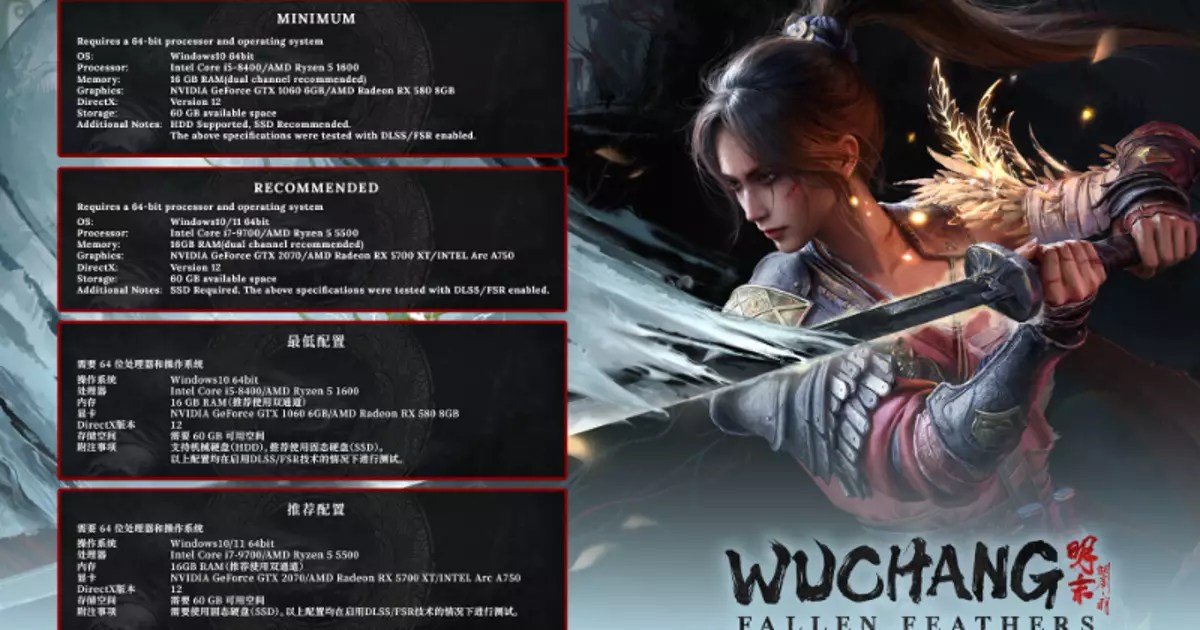Wuchang: Fallen Feathers emerges as an intriguing addition to the action-RPG genre that has historically been dominated by dark, gritty atmospheres and monstrous adversaries. Its premise — a vividly stylized universe inspired by the Ming Dynasty with a fantastical twist — promises players an experience that melds history, mythology, and supernatural chaos. The developer, Leenzee, has dedicated considerable effort to refining both visual aesthetics and gameplay mechanics, positioning Wuchang as a bold competitor amid titles like Bloodborne, but with its own unique cultural and narrative flair. One compelling facet is the game’s ability to invite players into a lush, fiery world ravaged by a feathered plague, transforming its inhabitants into winged mutants. This transformation isn’t merely cosmetic; it shapes the narrative and gameplay, emphasizing the thematic weight of decay, rebirth, and identity.
Visually Resilient Yet Accessible System Demands
There is an admirable restraint in the game’s hardware requirements, especially considering the scope of its visual ambition. The minimum specs — Intel Core i5-8400, GeForce GTX 1060, and 16GB RAM — suggest that Wuchang aims to be accessible to a broad audience without sacrificing visual richness. The recommended configuration (e.g., RTX 2070, Ryzen 5 5500) indicates an expectation that players will pursue higher fidelity experiences with more powerful hardware, particularly with features like DLSS 4 for Nvidia users. The emphasis on SSDs underscores a demand for smooth performance, crucial during frenetic boss battles or detailed exploration. It’s refreshing to see a game that balances ambition with practicality, promising a visually captivating adventure even on mid-range systems.
In-Depth Gameplay and Narrative Layers
At its core, Wuchang promises a compelling narrative of self-discovery intertwined with high-stakes combat. As the amnesiac pirate Wuchang, players traverse the myth-laden land of Shu, fighting against the monstrous plague that has turned townsfolk into feathered horrors. The game’s mechanics— notably the use of “Red Mercury” for unlocking techniques and weapon enchantments — foster a sense of progression that rewards strategic experimentation. The options for character customization, coupled with multiple endings based on player choices and secrets uncovered, invite a replayable richness to the experience. This design philosophy suggests that Wuchang isn’t just about reflexes but also about decision-making, alliances, and uncovering hidden truths buried within its layered narrative.
A Cultural Tapestry Wrapped in Myth and Morality
What sets Wuchang apart from many contemporaries is its cultural depth. By drawing from Chinese mythology and history, it crafts a universe that feels both authentic and fantastical. The aesthetic tweaks since 2021 — including a move away from a more blood-red imagery to a visually diverse palette — demonstrate a commitment to refining the game’s visual storytelling. This cultural tapestry enhances immersion, rooting the supernatural horrors in a recognizable yet mythic setting. The narrative’s focus on the protagonist’s quest to recover lost memories and confront moral dilemmas resonates with broader themes of identity, sacrifice, and resilience.
Personal Reflection and Industry Implications
In analyzing Wuchang’s presentation and promises, it becomes clear that the game aims to blend innovation with tradition, offering players a new lens through which to explore action-RPGs. Its approachable system requirements, coupled with detailed storytelling and powerful visual design, suggest a game that values player accessibility without compromising depth. Yet, the success of Wuchang will ultimately hinge on execution— how fluid combat feels, the richness of its storytelling, and the tangible sense of player agency in shaping outcomes. With its release just around the corner, Wuchang stakes a meaningful claim for those seeking a culturally infused adventure that challenges both reflexes and perceptions—a bold step forward for genre diversity and narrative complexity.


Leave a Reply